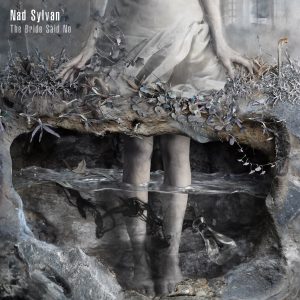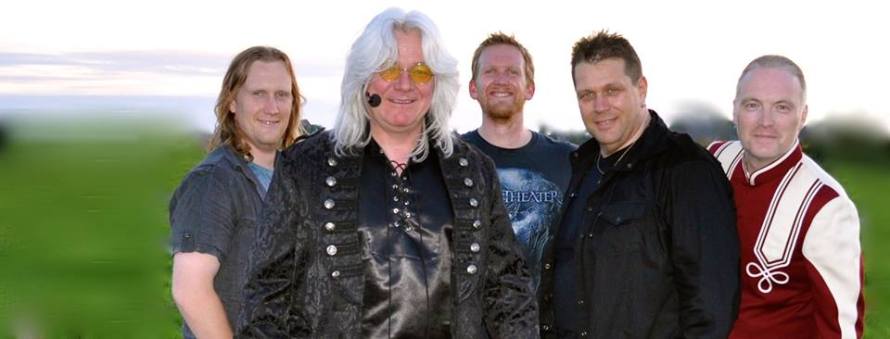Nad Sylvan | The Bride Said No | Album Review September 2017

Nad Sylvan | The Bride Said No
Label: InsideOut Music
Release Year: 2017
Country: Sweden
Genre: Progressive Rock
Band Members
Nad Sylvan – Lead Vocals/Electric & Acoustic (5) Guitars/Keyboards/Piano (5) Orchestrations (4,5,8) Pogramming (7) Poducer & Mxing
Additional Musicians
Tania Doko – Lead (8) & Backing (2) Vocals
Jade Ell – Lead (1,2,5,8) & Backing (4,5,7,8) Vocals
Sheona Urquhart – Lead (1,2) & Backing (4,5,7,8) Vocals/Saxophone (7)
Steve Hackett – Guitars (5-8)
Guthrie Govan – Guitar (5)
Roine Stolt – Guitar (6)
Anders Wollbeck – Keyboards & Programming (3)/ Orchestration (6)/Sound Design (1,2,4,8), co-producer (1,3,6)
Tony Levin – Chapman Stick (3,7)/ Upright bass (5)/ Electric Bass (7)
Jonas Reingold – Bass (2,4,6,8)/ Guitar Riff (4)
Nick D’Virgilio – Drums (2,4,6,8)/ Percussion (2)
Doane Perry – Drums (3,5,7)
Alfons Karabuda – Waterphone (3)
Track Listing
1. Bridesmaids (1:17)
2. The Quartermaster (5:38)
3. When The Music Dies (7:00)
4. The White Crown (6:15)
5. What Have You Done (8:29)
6. Crime Of Passion (5:59)
7. A French Kiss In An Italian Cafe (5:58)
8. The Bride Said No (12:26)
– silence (2:00)
9. Black Sheep – hidden track
Contact Links
Nad Sylvan Official Facebook Page
Nad Sylvan Official YouTube Channel
InsideOut Music Official Website
InsideOut Music Official YouTube Channel

Eccentric
A person of unconventional and slightly strange views or behavior.
Genius
Exceptional intellectual or creative power or other natural ability.
During his tenure with Genesis in the later 1960’s to early 1970’s Peter Gabriel was looked at the world over as being a bit odd, strange, different, theatrical, weird and even eccentric. With his choice of outfits on stage, to his public persona, Peter Gabriel could not escape the stereotypes that are mentioned above. Another thing Peter Gabriel was notorious for was his absolute genius with the creative side of the progressive rock and entertainment business.
After his departure from Genesis, Peter Gabriel began to really change into something else. This held totally true with the invention of MTV where Peter Gabriel had an era full of many field days with his video presentations. Some of MTV’s most notorious and strange videos came from Peter Gabriel with the likes of Games Without Frontiers, Shock The Monkey, Solsbury Hill and his juggernaut Sledgehammer. The fact that the world got to see this Eccentric Genius at work was a privilege to the world over. Over the years Peter Gabriel would tone down such presentations and focus more on the musical aspect. This left a void in progressive rock/ art rock until Nad Sylvan came along, thus the Eccentric Genius has come in a different individual. This also would shape his image and sound going into another great progressive rock band Nad Sylvan fronted and that being Agents Of Mercy.
Nad Sylvan is a bit of a Eccentric Enigmatic Genius in the fact he really marches to his own distinctive vision and beat. Nad Sylvan is like the ‘Second Coming’ to Peter Gabriel. This is probably why Steve Hackett has invited Nad Sylvan on stage on many occasions to perform early Genesis material with The Steve Hackett Band. However as much as he is a reminder of Peter Gabriel, Nad Sylvan also has his own thing going for him and it certainly shines through with his latest offering The Bride Said No.
The Bride Said No is a continuation of his last album Courting The Widow in 2015. The story picks up where the female character is at in her relationship with her potential suitor/husband. This time with The Bride Said No, Nad Sylvan certainly explores much darker subject manner with both the instrumental part and the lyrical vocal part. The Bride Said No is also a little shorter and to the point than Courting The Widow was. Throughout the album there are many things going on and I will point these highlights out going forward.
Bridesmaids is a opening instrumental with special effects to simulate the ocean crashing on to the shore. We already see the female character second guessing or getting cold feet perhaps. The effects and instrumental are done wonderfully here.
The Quarter Master transitions seamlessly with perfect timing from Bridesmaids. This song also displays a very dark side on the album and of Nad Sylvan’s creative prowess. The heavy Hammond style organ already gives this song a deep layer of sheer darkness and conflict within the narrative of the lyrical content. The dark portion from the Hammond Organ also adds a deep layer inside the bass/drum rhythm section. The guitars work on both the stringed section and the rhythm section equally throughout the song. There are effects of people chanting here as well. On the vocal and lyrical narrative the song talks about the adventures into the night of a drunk in the masculine form. The instrumental displays the drunken sailor and his emotions and point of view perfectly. Soon a female vocal comes in as a female character explaining to the narrator specific warnings on the drunken man.
When The Music Dies is a bit of a departure within the concept. It has the appearance of a brief intermission. This incredibly soulful track is a dedication to all the great progressive rock giants we lost over the last few years. The song is written in such a way that it could become a possible single. This is also written, recorded and mastered in such a way as to have some appeal for those who are not really into this brand of progressive rock. The instrumental sections alongside the lyrical sections present a warm inviting atmosphere of reflection to the listener.
The White Crown begins with a beautiful eclectic intro that comes in the tradition of early Genesis, especially the Foxtrot and Trespass eras. This track also ventures into the ‘Heavy Prog’ territory with a much heavier and darker chord progression that is met with a deep Hammond style organ and heavy 1970’s style progressive rhythm sections. By this point on The Bride Said No the listener starts to see that this epic story explores the darker emotions and the instrumental and vocal certainly adds much towards those darker emotions. There is a part where the synth’s go out into a more psychedelic area. The irony is that in all the dark instrumental sections, Nad Sylvan’s voice always remains as a positive optimism about it. This part of the story lyrically is one of heartbreak and introspection.
What Have You Done starts out with a beautiful piano and keyboard in perfect melody within their respective isolation on the engineered intro. Soon another layer of isolation appears in form of Nad Sylvans eccentric angelic vocal. This song can constitute as a ballad easily. The slower and lighter aesthetic allows the album to breathe and the listener more time to soak in and digest the album. The listener is able to look backward on the story and anticipate that latter half of the album. There is some beautiful guitar work on this one from Steve Hackett and Guthrie Govan. The special effect of a choir on here adds another layer of beauty to the composition.
Crime Of Passion opens up with a angelic atmosphere of a choir once again. Soon the track starts to rock on all cylinders with the deep rhythm sections and guitars. This track brings together elements of 1970’s original progressive rock with 1980’s neo progressive rock with very current and modern elements. With all those elements happening this song would hold up in any decade of progressive rock. This song lyrically has the male character in the story start to really question himself in relation to his potential bride. The instrumental half of this perfectly supports this introspective emotion.
A French Kiss In A Italian Cafe starts out with Tony Levin leading with a beautiful stand up bass with the drums. Soon the isolated vocal of Nad Sylvan shines through where the story can so eloquently be told. This track is very heavy in the rhythm section. It is this rhythm section that adds layers of beauty and layers of atmosphere to maintain the attention of the objective listener. The drum plays heavily off the snare on this one moving it forward with great continuity and grace. Sheona Urquhart lends a very beautiful Saxophone in the closing moments of the track.
The Bride Said No starts with a intro that is slowly faded in through world class engineering. One again the opening is very heavy on the on rhythm with a beautiful bass and snare lead drums. This is the first time in the story on the narrative we experience actual dialogue between the female and male characters. Sheona Urquhart & Jade Li has such a Kate Bush style of beauty in her vocal that perfectly compliments Nad Sylvan’s male narrative. Although they really love one another the male and female characters they come to the realization it may be better to depart and go their separate ways for their own personal reasons. The instrumental side to this has beautiful Hammond style organs and guitar solo’s that give the song the epic countenance it truly is. Instrumentally the track ends on a very positive and uplifting note.
After Courting The Widow and now its companion The Bride Said No I truly believe that Nad Sylvan has some very pivotal here. Please go back and listen to Courting The Widow first and then The Bride Said No will make better sense. These projects have great potential to be live classics. I certainly hope Nad Sylvan does perform both of these in their entirety live someday with some CD/DVD Bluray treatment. Through emotion and top notch musicianship The Bride Said No is on its way to becoming a ‘Prog Classic’. With The Bride So No, Nad Sylvan has established himself as a force to be reckoned with. I give Nad Sylvan’s The Bride Said No a 5/5.



